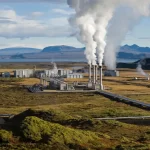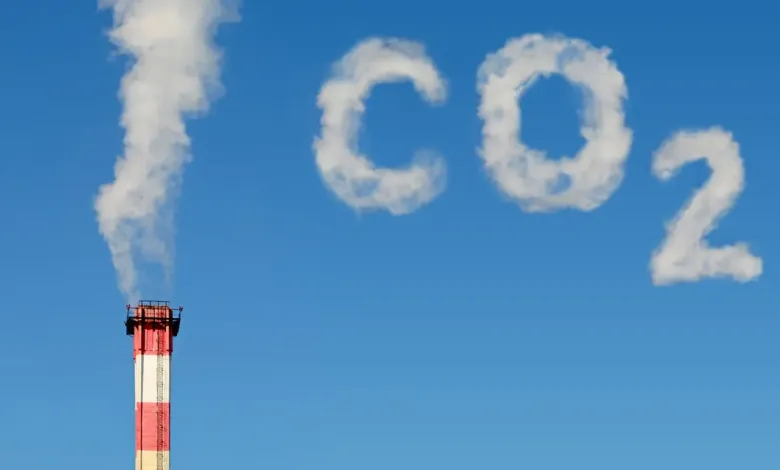Chemically, carbon dioxide is very simple – it’s just one carbon atom bonded to two oxygen atoms. Together they create a colorless gas that makes up only a small part of Earth’s atmosphere, about 0.04%.
This gas is important to life on Earth because plants use sunlight and carbon dioxide to generate energy through photosynthesis.
But carbon dioxide is also the main cause of climate warming, a long-term temperature shift that threatens the delicately balanced ecosystems that humans depend on.
So how is something that is essential to life also so harmful? Here’s what you should know:
Why does carbon dioxide cause global warming?
The Earth is heated by the sun–about 71% of the solar energy that arrives is absorbed by the atmosphere and surface and 29% is reflected back into space, according to NASA.
The energy that comes from the sun alone is not enough to keep the earth warm. For that, we need Earth’s atmosphere, which acts like a blanket that traps some of the heat, said Scott Denning, a professor of atmospheric sciences at Colorado State University.
And this “blanket” consists of several gases, which are called “greenhouse gases”, because they retain heat, just like the glass panels of a greenhouse retain the heat of the sun.
Denning said the greenhouse effect is a natural process. “It is really fortunate that we have air.” Without it, Earth would be just a frozen white ball suspended in space – uninhabitable, but this natural process is beginning to change as humans burn fossil fuels.
Is carbon dioxide a greenhouse gas?
Earth’s atmosphere is made up of 78% nitrogen and 21% oxygen, with only 1% being other things. Greenhouse gases are among those “other things”.
Carbon dioxide is a greenhouse gas, one of the four major gases. In terms of greenhouse gas emissions in the United States, here’s a list of amounts from the Environmental Protection Agency:
carbon dioxide 79%
Methane (natural gas) 11%
nitrous oxide 7%
fluorinated gases 3%
What does carbon dioxide mean?
You will often see carbon dioxide written in the name of its chemical formula, CO2. This simply means that it is a molecule containing one carbon atom and two oxygen atoms.
In chemical texts it is written like this: carbon dioxide where a low number indicates the presence of two oxygen atoms.
How does carbon dioxide act as a greenhouse gas?
Carbon dioxide is great at retaining heat in part because it’s a larger molecule than nitrogen (78%) and oxygen (21%), which make up most of Earth’s atmosphere. Each is composed of two atoms, not three, or two nitrogen or two oxygen.
This geometry means that it only interacts with a narrow wavelength of light. The more complex geometry of carbon dioxide molecules means they can absorb a much wider range of light waves, including infrared waves that carry heat.
So the more carbon dioxide molecules there are in the atmosphere, the more heat they can trap.
It’s a delicate balance, too little carbon dioxide and the Earth won’t stay at a temperature suitable for life, too much and the temperature starts to rise.
Note that carbon dioxide is the most discussed greenhouse gas because although it is less potent than some like methane (natural gas), it remains in the atmosphere for hundreds and even thousands of years.
Where does carbon dioxide come from?
Carbon dioxide is what people and animals exhale after breathing in oxygen. But this is balanced by the plants we eat, so humans and animals do not affect the balance of carbon dioxide in the atmosphere. It’s a cycle, humans and other animals exhale carbon dioxide but it’s the same carbon that’s been “breathed out” by the plants we eat, so it doesn’t contribute to global warming.
Carbon dioxide in the atmosphere comes from two main sources, natural and human activities. Natural carbon dioxide comes from outgassing from the oceans, decomposing plants, wildfires and volcanoes.
Humans began to change the balance of greenhouse gases in the atmosphere around 1750. That’s when the Industrial Revolution began in England and factories began burning coal to power machinery. This added new carbon dioxide to the atmosphere from fossil fuels that had been buried deep within the Earth for millions of years.
Here’s how much the balance has shifted: Over the past 400,000 years, the amount of carbon dioxide in the atmosphere has fluctuated between 200 and 280 parts per million, according to NASA.
In 1750 the amount of carbon dioxide in the atmosphere was estimated at 280 parts per million.
Today, it has risen to 418 ppm, the highest level in 3.6 million years.
As people started burning more fossil fuels, the amounts increased. According to NASA, half of the increase in atmospheric carbon dioxide concentrations in the last 300 years has occurred since 1980, and a quarter of it since 2000.
How could such a tiny amount of carbon dioxide cause so much trouble?
The difference between 280 parts per million and 418 may not seem like much, but it does mean that humans have generated an estimated 1.5 trillion tons of carbon dioxide pollution in the past 150 years.
This means that the blanket around the floor has become thicker and has an effect. Since 1880, the global annual temperature has increased by 1.9 degrees, with most of the warming occurring since 1975.












